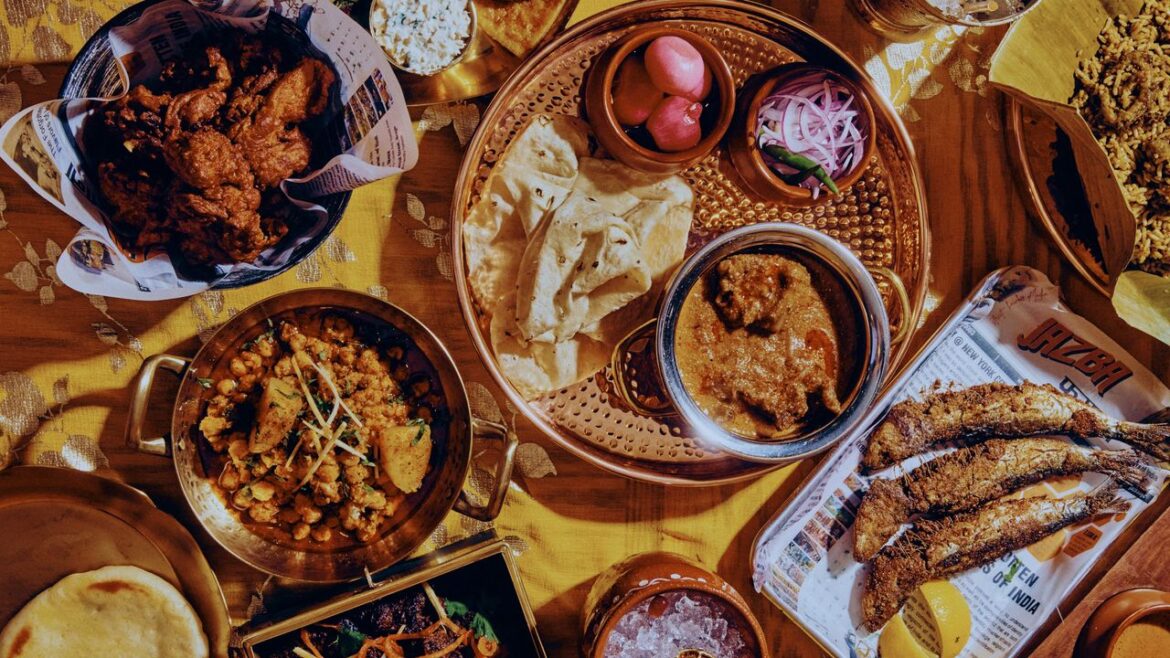It isn’t just the food; many of these new spaces also challenge preconceptions around what Indian restaurants should look like. Passerine, which opened in time for Diwali last year, is a chic, low-lit space in Flatiron that’s dressed in leather and zebra and botanical prints. Here, chef Chetan Shetty relies on the flavors from his hometown of Pune to churn out dishes like a Konkani monkfish curry and a chai-rose ice cream. The restaurant recently launched a seven-course tasting menu, currently paired with heritage Lebanese wines. “Indian restaurants can be a sexy Friday night out too,” says Alvina Patel, who co-owns Passerine with restaurateur Maneesh Goyal.
To eat at any of these places is to realize that Indian restaurants no longer need to cater to a Western palate—or frameworks of reference. “We don’t have to pretend we’re anything that we are not,” says Vijay Kumar. At Semma, names of dishes, however unpronounceable to unfamiliar audiences, like uzhavar santhai poriyal (a beet-and-squash stir-fry) or muyal pirattal (rabbit leg), are left untouched. At Chatti, the small plates are colloquially called “touchings” because they’re meant to be eaten without cutlery.
“It’s much bigger than just the food; it’s about culture and community and identity,” says Khanna.
It was out of a need to create a sense of community that prompted Shwetha and Venkat Raju to set up Brooklyn Curry Project, a weekend dosa pop-up that started drawing lines at the Fort Greene Saturday farmers market, and now operates out of a commercial kitchen in Downtown Brooklyn. “We moved from Bangalore to New York for our jobs, but we missed our people,” says Shwetha. “This was our way of using our food to get to know people and have them get to know our culture.” Every Saturday morning, a steady stream of people files into the makeshift café, claiming a handful of tables and chairs and studying the handwritten menu. Most order dosas, but there are idlis and filter coffee, and depending on the weekend, specials like peppery mutton roast or pineapple kesari bath. The open kitchen is helmed by a cast of friends and family; the Rajus ping-pong between pouring dosas and chatting with customers.
Last year, they began hosting family-style lunches with a focus on Kannada food, with produce sometimes shipped over from Swetha’s parents’ farm in Bengaluru. Menus are posted online and attract a diverse group of diners from the tristate area. At a recent lunch to celebrate Sankranti, a Hindu harvest festival, for instance, diners feasted on an Udipi-style thali with dishes like turnip masala vada, puliyogare (tamarind rice), and avarekalu usili (broad bean curry). Venkat filled, then refilled, stainless steel tumblers with freshly squeezed, sticky-sweet sugarcane juice; Shwetha, in a handloom sari, patiently answered questions about ingredients and preparation. “It makes me excited about reviving all the heirloom recipes that we are at the risk of losing.” Brooklyn Curry Project is currently crowdfunding for a permanent restaurant.
There’s much more yet to come. London’s world-famous Indian restaurant Dishoom—purveyor of eggs kejriwal and chili cheese toasts—is rumored to be eyeing a New York location after testing the waters with a weeklong breakfast pop-up at Pastis last year. Another London-based group behind Indian restaurants like Gymkhana is also said to be tying up a Manhattan location. And later this year, Unapologetic Foods hopes to follow the Adda expansion with Kebabwala, which will pay homage to iconic roadside kebab joints like Mumbai’s Bademiya that sling melt-in-your-mouth paneer and juicy reshmi tikka straight off the grills to late-night diners crowding the sidewalk and leaning against cars. Pandya hopes it will deliver the “spirit” of those places as much as the food. “You shouldn’t have to dress up for a great kebab,” he says.
Older restaurants like Junoon are also clocking the evolving palate. “Ten years ago we had foie gras-duck terrine on the menu, which had no roots to India and was made with European technique and flavors,” says Akshay Bhardwaj, Rajesh’s son and the executive chef at Jazba and Junoon. “Today, we might still use ingredients like truffles and caviar, but they are just final touches on our khichdi and puchka dishes.”
Khanna believes there’s plenty of room for more—“Do we ever say there are too many Italian restaurants?”—but adds that the current generation of chefs owes much to the restaurants that came before them: from the neighborhood joints serving a rotation of standards to the upscale restaurants that forced a space for modern Indian fare within the pantheon of New York fine dining. “They fought bigger battles,” he says. “We stand on their shoulders.”



